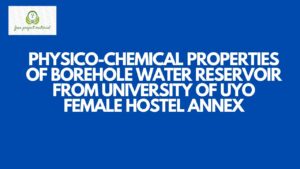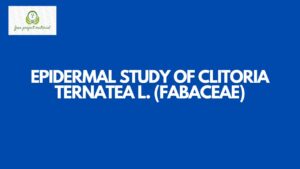ABSTRACT
Using standard method of analysis, bioaccumulation factor of gastropods from Ayadeghe beach showed T. fuscatus. Zn(0.73) >Ni (0.60) >Cr (0.19) >Cd(0.07) > Pb(nil); E. radiata; Zn (0.33) > Cd(0.07) >Cr (0.06) > Ni (0.03) > Pb (Nil). Zn was noticed to have highest B.F and all the value were below 1. Heavy metal pollution of samples collected did not roister alarming status. This explains the safety of T. fuscatus and E. radiata from Ayadeghe beach for consumption.
TABLE OF CONTENTS
Title Page – – – – – – – – – i
Certification – – – – – – – – ii
Dedication – – – – – – – – – iii
Acknowledgments – – – – – – – iv
Abstracts – – – – – – – – – v
Table of Contents – – – – – – – – vi-viii
CHAPTER ONE: INTRODUCTION
- Background of the Study – – – – – 1-3
- Aim – – – – – – – – – 3
- Objectives of the Study – – – – – – 3-4
- Scope and Limitation of the Study – – – – 4
- Definition of Terms – – – – – – 4-5
CHAPTER TWO: LITERATURE REVIEW
2.1 Biology of Tympanotonus fuscatus – – – – 6
2.1.1 Habitat of Tympanotonus fuscatus – – – 6
2.1.2 Feeding of Tympanotonus fuscatus – – – – 6-7
2.1.3 Life Cycle of Tympanotonus fuscatus – – – – 7-8
2.2 Biology of Egeria radiata – – – – – 8
2.2.1 Habitat of Egeria radiata – – – – – 8
2.2.2 Feeding of Egeria radiata – – – – – 9-10
2.2.3 Life Cycle of Egeria radiata – – – – – 10-11
2.3 Biological Important of Heavy Metals Analyzed – – 11
2.3.1 Cadmium (Cd) – – – – – – – 11-12
2.3.2 Chromium (Cr) – – – – – – – 12-14
2.3.3 Lead (Pb) – – – – – – – – 14-15
2.3.4 Zinc (Zn) – – – – – – – – 15-18
2.3.5 Nickel (Ni) – – – – – – – – 19
CHAPTER THREE: MATERIALS AND METHOD
3.1 Materials – – – – – – – – 20
3.1.1 Equipment/Apparatus – – – – – – 20
3.1.2 Reagent Used – – – – – – – 21
3.2 Methods – – – – – – – – 21
3.2.1 Study Area – – – – – – – – 21-22
3.2.2 Collection of Sample – – – – – – 23
3.2.3 Sample Preparation and Analysis – – – – 23-24
CHAPTER FOUR: RESULTS AND DISCUSSION
4.1 Result s- – – – – – – – – 25-27
4.2 Discussion – – – – – – – – 28-31
CHAPTER FIVE: CONCLUSION AND RECOMMENDATION
5.1 Conclusion – – – – – – – – 32
5.2 Recommendation – – – – – – – 33
References
CHAPTER ONE
INTRODUCTION
1.1 The Background of the Study
Seafood was reported by Otitoju and Otitoju (2013) to be a rich source of nutrients but its nutritional values may be altered based on the environment in which these organisms live. These important seafood (Tympanotonus fuscatus and Egeria radiata inclusive) sources constitute a major part of the diet in the Niger Delta region of Nigeria, where they are traditionally cooked at times without removing the shells, in the case of periwinkles, before consumption and these organisms could be contaminated with heavy metals which may be detrimental to the health of children, pregnant women and even the general public.
Large number of people living in the Niger Delta region of Nigeria consumes periwinkles and clams as seafood harvested from different water bodies laden with history of crude oil spillage and other industrial activities. Heavy metals are highly toxic and persistent in nature in the environment (Otitoju and Otitoju, 2013). These metals in the form of inorganic compounds from natural and anthropogenic sources continuously enter the aquatic ecosystem where they could pose serious threat to the food chain.
Ayadeghe beach is part of the lower Cross River system which like other rivers plays a major role in the development of Akwa Ibom state by providing easy means of transport, occupational activities, source of food and means of waste disposal.
Human related activities at Ayadeghe beach include: small scale farming, trading and artisanal fisheries. T. fuscatus and Egeria radiata which are commonly used in preparing some delicious native foods like Ekpang Nkukwo or Asa prepared from water-yam or coco-yam and cassava. It obvious that these benthos have the ability to accumulate pollutants without being killed by the level encountered in the environment. Moslen et al. (2017) reported of molluscs as one of the aquatic invertebrate which can accumulate heavy metals many hundred folds and therefore can raise the level which may be of no significant in water to the point of which their tissue become highly hazardous to organisms that consume them. Being deposit feeders and bio-indicators of heavy metals and hydrocarbon pollution in aquatic environment, and also of high commercial and economic values for the area, there is need to assess the bio-accumulative factors of these organisms comparatively to ascertain their suitability for human consumption
1.2 Aim
The basic aim of this study was to determined comparatively the assessment of bioaccumulation factor (from sediment to flesh) between two gastropods (Tympanotonus fuscatus and Egeria radiate) from the Lower Cross River System.
1.3 Objectives
- To determine comparatively, levels of heavy metals (Cd, Cr, Pb, Zn and Ni) in water sediment and fleshes of Tympanotonus fuscatus and Egeria radiata.
- To assess the bioaccumulative factor (BAF) for heavy metals studied from sediment to flesh of T. fuscatus and Egeria radiata from Ayadeghe beach.
- To compare the result obtained with WHO permissible range.
- To ascertain the suitability of T. fuscatus and Egeria radiata from Ayadeghe beach for consumption.
1.4 Scope and Limitation of the Study
This work only covers heavy metals such as Cd, Cr, Pb, Zn and Ni due to financial constraint and availability of materials for depth analysis.
1.5 Definition of Terms
(i) Bioaccumulation: This can be defined as the gradual accumulation of substances, such as pesticides or other chemicals in an organisms.
(ii) Heavy metals: They are generally defined as metals with relatively high densities, atomic weights or atomic numbers.
(iii) Digest: Is a breakdown (food) in the alimentary canal into substances that can be absorbed and used by the body.
(iv) Digestion: Is the complex process of turning the food consumed into nutrients which the body uses for energy, growth and cell repair needed to survive.
(v) Anthropogenic activities: Anthropogenic designates an effect or object resulting from human activity. Anthropogenic activities include burning of fossils, planting N-fixing crops, fertilizers production and waste water disposal. Anthropogenic activities have increased the pollution level to such an extent that the ecosystem has witnessed major drastic changes in the predator-prey relationship.
(vi) Bioaccumulative factor: Is the ratio of the concentration of the substance in a specific genus to the exposure concentration at equilibrium.



